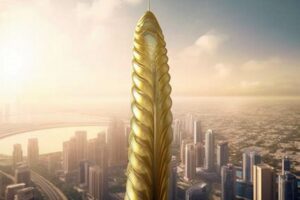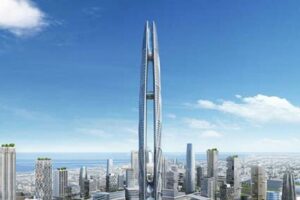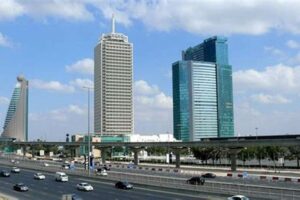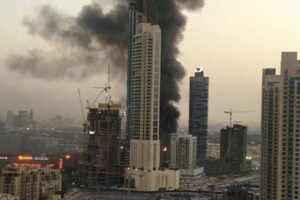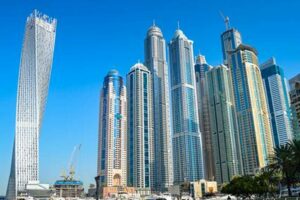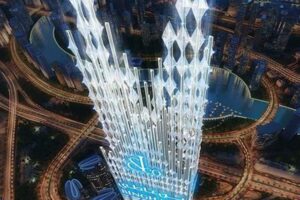The Burj Khalifa is a megatall skyscraper in Dubai, United Arab Emirates. With a total height of 829.8 m (2,722 ft) and a roof height of 828 m (2,717 ft), the Burj Khalifa has been the tallest structure in the world since its completion in 2010.
The Burj Khalifa was designed by Adrian Smith of Skidmore, Owings & Merrill, and its construction was led by Samsung C&T Corporation. The building contains 162 floors, including residential, commercial, and hospitality units. The Burj Khalifa is a popular tourist destination, and its observation deck on the 124th floor offers panoramic views of Dubai.
The Burj Khalifa is a symbol of Dubai’s economic and architectural achievements. It is one of the most iconic buildings in the world and has been featured in numerous films and television shows.
1. Height
The Burj Khalifa’s height of 828 meters (2,717 feet) is a major factor in its status as the biggest skyscraper in Dubai. This extraordinary height:
- Provides unparalleled views: The Burj Khalifa’s observation deck on the 124th floor offers breathtaking panoramic views of Dubai, making it a popular tourist destination.
- Enhances architectural significance: The building’s height makes it an iconic landmark and a symbol of Dubai’s architectural achievements.
- Poses engineering challenges: Constructing a building of such height requires advanced engineering techniques and materials to ensure structural stability and safety.
- Requires specialized elevators: The Burj Khalifa’s height necessitates high-speed elevators with advanced technology to efficiently transport people and goods throughout the building.
In conclusion, the height of 828 meters (2,717 feet) is a defining characteristic of the Burj Khalifa, contributing to its architectural significance, engineering marvel, and status as the biggest skyscraper in Dubai.
2. Floors
The Burj Khalifa’s 162 floors are a key aspect of its status as the biggest skyscraper in Dubai. This extraordinary number of floors:
- Maximizes space utilization: The 162 floors allow for a vast amount of usable space, accommodating a diverse range of functions such as residential units, offices, retail stores, and hospitality venues.
- Facilitates diverse usage: The multiple floors enable the Burj Khalifa to cater to a wide range of occupants and activities, creating a vibrant and multifaceted community within a single structure.
- Enhances structural stability: The distribution of weight across 162 floors contributes to the building’s overall stability, ensuring its resilience against strong winds and seismic activity.
- Requires advanced elevator systems: The 162 floors necessitate a sophisticated elevator system with multiple high-speed elevators to efficiently transport people and goods throughout the building.
In conclusion, the 162 floors of the Burj Khalifa are integral to its status as the biggest skyscraper in Dubai, enabling diverse usage, maximizing space utilization, enhancing structural stability, and necessitating advanced elevator systems.
3. Architect
Adrian Smith, a renowned architect, played a pivotal role in the design and construction of the Burj Khalifa, the biggest skyscraper in Dubai. His expertise and innovative approach significantly contributed to the building’s architectural marvels and overall success.
- Innovative Design: Smith’s vision for the Burj Khalifa involved creating a structure that would redefine the limits of architecture. He incorporated unique design elements, such as the building’s triangular cross-section and buttressed core, to achieve both structural stability and aesthetic appeal.
- Sustainability Considerations: Smith prioritized sustainability throughout the design process. The Burj Khalifa incorporates energy-efficient systems, such as double-glazed windows and a rainwater harvesting system, reducing its environmental impact and contributing to its LEED Platinum certification.
- Structural Expertise: Smith’s engineering background and understanding of structural mechanics were crucial in ensuring the stability of the Burj Khalifa. He employed innovative techniques, including the use of high-performance concrete and advanced wind engineering, to withstand the challenges posed by the building’s immense height and exposure to extreme weather conditions.
- Collaboration and Leadership: Smith effectively collaborated with a team of engineers, architects, and construction professionals to bring his vision to life. His leadership and ability to inspire others played a significant role in coordinating the complex design and construction process.
In conclusion, Adrian Smith’s expertise, innovative approach, and commitment to sustainable design were instrumental in the creation of the Burj Khalifa, solidifying its status as the biggest skyscraper in Dubai and a testament to architectural ingenuity.
4. Construction Company
Samsung C&T Corporation, a South Korean conglomerate, played a pivotal role in the construction of the Burj Khalifa, the biggest skyscraper in Dubai. Their expertise and capabilities were instrumental in bringing this architectural marvel to life.
- Engineering Prowess: Samsung C&T Corporation leveraged its advanced engineering capabilities to overcome the challenges of constructing a building of such immense height. Their innovative techniques and use of cutting-edge materials ensured the structural integrity and stability of the Burj Khalifa.
- Project Management Expertise: The company’s project management skills were crucial in coordinating the complex construction process. They effectively managed a vast team of engineers, architects, and construction workers, ensuring seamless execution and adherence to the project timeline.
- Global Experience: Samsung C&T Corporation’s extensive experience in constructing iconic landmarks worldwide contributed to their success with the Burj Khalifa. They applied their knowledge and expertise gained from previous projects to meet the unique demands of this extraordinary building.
- Commitment to Quality: Samsung C&T Corporation maintained the highest standards of quality throughout the construction process. Their meticulous attention to detail and unwavering commitment to excellence resulted in a building that has become a symbol of architectural achievement.
In conclusion, the involvement of Samsung C&T Corporation as the construction company was pivotal to the successful completion of the Burj Khalifa, the biggest skyscraper in Dubai. Their engineering prowess, project management expertise, global experience, and commitment to quality were instrumental in creating this architectural masterpiece.
5. Completion year
The completion of the Burj Khalifa in 2010 marked a significant milestone in the history of architecture and engineering, solidifying its status as the biggest skyscraper in Dubai. The building’s exceptional height and innovative design pushed the boundaries of construction capabilities and set new standards for vertical living and urban development.
- Architectural Innovation: The Burj Khalifa’s completion in 2010 showcased groundbreaking architectural techniques and materials. Its unique Y-shaped floor plan, buttressed core, and high-performance concrete contributed to its structural stability and iconic silhouette.
- Engineering Marvel: Completing the Burj Khalifa required innovative engineering solutions to overcome the challenges of constructing a building of such immense height. Engineers employed advanced wind engineering techniques, reinforced concrete structures, and specialized equipment to ensure the building’s resilience against strong winds and seismic activity.
- Global Recognition: The completion of the Burj Khalifa in 2010 propelled Dubai onto the global architectural stage. The building’s record-breaking height and striking design garnered international attention and recognition, establishing Dubai as a hub for innovation and architectural excellence.
- Economic Impact: The construction and completion of the Burj Khalifa had a significant economic impact on Dubai. It created numerous job opportunities, stimulated investment in the real estate sector, and contributed to the growth of tourism and hospitality industries in the emirate.
In conclusion, the completion of the Burj Khalifa in 2010 not only established it as the biggest skyscraper in Dubai but also represented a testament to human ingenuity, architectural advancement, and the city’s unwavering pursuit of innovation and progress.
6. Observation deck
The observation deck on the 124th floor is an integral component of the Burj Khalifa’s status as the biggest skyscraper in Dubai. Here’s why:
- Unparalleled Views: The observation deck offers breathtaking panoramic views of Dubai from an unparalleled height. Visitors can marvel at the city’s iconic landmarks, including the Palm Jumeirah, the Dubai Marina, and the Burj Al Arab, from a unique perspective.
- Tourist Attraction: The observation deck is a major tourist attraction, drawing millions of visitors each year. It provides tourists with a memorable experience and allows them to appreciate the scale and grandeur of the Burj Khalifa and Dubai’s urban landscape.
- Architectural Significance: The observation deck is an architectural marvel in its own right. It is the highest observation deck in the world, offering visitors a thrilling and unforgettable experience.
- Economic Impact: The observation deck contributes to Dubai’s economy by generating revenue from ticket sales and attracting tourists to the city. It also supports local businesses by providing employment opportunities.
In conclusion, the observation deck on the 124th floor is the Burj Khalifa’s biggest attraction but also a key factor in its status as the biggest skyscraper in Dubai. It offers unparalleled views, serves as a major tourist attraction, holds architectural significance, and contributes to the city’s economy.
7. Cost
The construction of the Burj Khalifa, the biggest skyscraper in Dubai, involved substantial financial investment. The building’s total cost of $1.5 billion is a significant factor contributing to its status as the tallest structure in the world.
The high cost of constructing the Burj Khalifa can be attributed to several factors:
- Height and complexity: The building’s immense height and intricate design required advanced engineering techniques, specialized materials, and a highly skilled workforce, all of which contributed to the overall cost.
- Materials and technology: The Burj Khalifa incorporates high-quality materials, including glass, steel, and reinforced concrete, along with cutting-edge technology for its elevators, communication systems, and other building systems.
- Labor and logistics: The construction process involved a vast workforce and complex logistics, including the transportation of materials and equipment to the site and the coordination of thousands of workers.
The significant investment in the construction of the Burj Khalifa has had a profound impact on Dubai’s economy and urban development:
- Economic growth: The project created numerous job opportunities and stimulated economic activity in various sectors, including construction, real estate, and tourism.
- Urban development: The Burj Khalifa has become a focal point of Dubai’s skyline and a symbol of the city’s ambitious architectural vision, attracting investment and contributing to the growth of the surrounding area.
- Global recognition: The building’s iconic status and record-breaking height have garnered international attention and recognition, further enhancing Dubai’s reputation as a global hub for innovation and architectural excellence.
In conclusion, the cost of $1.5 billion is an essential component of the Burj Khalifa’s status as the biggest skyscraper in Dubai. It reflects the engineering challenges, material quality, construction complexity, and economic impact associated with creating such an extraordinary architectural marvel.
8. Materials
In the construction of the Burj Khalifa, the biggest skyscraper in Dubai, the choice of materials played a critical role in achieving its record-breaking height and structural integrity. The primary materials used in the building’s construction are glass, steel, and concrete, each contributing to the building’s overall stability, aesthetics, and functionality.
Glass, with its transparent properties, allows for an abundance of natural light to penetrate the building’s interior, reducing the need for artificial lighting and creating a more energy-efficient environment. The extensive use of glass also contributes to the building’s striking appearance, giving it a sleek and modern aesthetic. Steel, known for its strength and durability, is used extensively in the building’s framework and structural components. The high strength-to-weight ratio of steel allows for the creation of slender and lightweight structures, making it an ideal choice for high-rise buildings like the Burj Khalifa. Concrete, with its ability to withstand compressive forces, is used in the construction of the building’s core and foundation. The concrete core provides stability and rigidity to the structure, enabling it to withstand strong winds and seismic activity.
The combination of glass, steel, and concrete has resulted in a building that is not only visually impressive but also structurally sound and energy-efficient. The use of these materials has played a vital role in making the Burj Khalifa the biggest skyscraper in Dubai and a testament to the advancements in construction technology and engineering.
9. Purpose
The Burj Khalifa, as the biggest skyscraper in Dubai, serves a multifaceted purpose that encompasses residential, commercial, and hospitality functions. This diverse utilization is a significant factor contributing to its status as the tallest structure in the world.
The residential component of the Burj Khalifa provides luxurious living spaces in the sky, offering breathtaking views of Dubai’s skyline. Its apartments and penthouses cater to a discerning clientele seeking an elevated lifestyle with exclusive amenities and services. The commercial aspect of the building houses a range of businesses, including offices, retail outlets, and fine dining restaurants. This integration of commercial spaces within the skyscraper creates a vibrant and dynamic environment, attracting professionals, entrepreneurs, and visitors alike.
The hospitality component of the Burj Khalifa is represented by the Armani Hotel Dubai, which occupies the lower floors of the building. This world-renowned hotel offers guests an unparalleled experience of luxury and sophistication, complemented by stunning views of the surrounding cityscape. The hotel’s presence not only enhances the building’s overall appeal but also contributes to Dubai’s reputation as a global tourism destination.
In conclusion, the combination of residential, commercial, and hospitality purposes within the Burj Khalifa is a strategic move that optimizes the building’s functionality and maximizes its value. This diversified utilization ensures the skyscraper’s continued relevance and success, solidifying its position as the biggest and most iconic structure in Dubai.
Frequently Asked Questions about the Biggest Skyscraper in Dubai
The Burj Khalifa, standing as the biggest skyscraper in Dubai, has captured global attention and raised various questions. This section aims to address some of the most common inquiries surrounding this architectural marvel.
Question 1: What is the height of the Burj Khalifa?
Answer: The Burj Khalifa stands at an impressive 828 meters (2,717 feet) tall, making it the tallest structure in the world.
Question 2: How many floors does the Burj Khalifa have?
Answer: The Burj Khalifa boasts 162 floors, offering a diverse range of residential, commercial, and hospitality spaces.
Question 3: Who is the architect behind the Burj Khalifa?
Answer: The renowned architect Adrian Smith, known for his innovative designs, is the mastermind behind the Burj Khalifa’s iconic structure.
Question 4: How long did it take to build the Burj Khalifa?
Answer: The construction of the Burj Khalifa was a remarkable feat of engineering, completed within a span of six years, from 2004 to 2010.
Question 5: What materials were used to construct the Burj Khalifa?
Answer: The Burj Khalifa’s construction involved a combination of high-quality materials, including glass, steel, and reinforced concrete, ensuring its structural integrity and durability.
Question 6: What is the purpose of the Burj Khalifa?
Answer: The Burj Khalifa serves a multifaceted purpose, accommodating residential apartments, commercial offices, and the luxurious Armani Hotel Dubai, making it a thriving hub for living, working, and leisure.
In conclusion, the Burj Khalifa stands as a testament to human ingenuity and architectural prowess. Its exceptional height, innovative design, and diverse functionality have solidified its position as the biggest and most iconic skyscraper in Dubai, attracting global attention and admiration.
Moving on to the next section, we will delve deeper into the architectural significance and impact of the Burj Khalifa.
Tips for Visiting the Biggest Skyscraper in Dubai
The Burj Khalifa, standing as the biggest skyscraper in Dubai, offers an unparalleled experience to visitors. To make the most of your visit to this architectural marvel, consider these informative tips:
Tip 1: Book Your Tickets in Advance:
Due to its popularity, it is highly recommended to book your tickets to visit the Burj Khalifa in advance. This will ensure your entry to the observation decks and avoid long queues, especially during peak tourist seasons.
Tip 2: Choose the Right Observation Deck:
The Burj Khalifa offers two observation decks: At the Top on the 124th floor and At the Top Sky on the 148th floor. The At the Top deck offers breathtaking views of the city, while the At the Top Sky deck provides an even more exclusive and elevated experience with panoramic vistas.
Tip 3: Go During Non-Peak Hours:
To avoid crowds and enjoy a more relaxed visit, plan your visit during non-peak hours. Early mornings or late evenings offer fewer crowds, allowing you to savor the stunning views without feeling rushed.
Tip 4: Take Advantage of the Burj Khalifa App:
Download the official Burj Khalifa app before your visit. It provides valuable information about the building, including real-time updates on wait times, interactive tours, and access to exclusive content.
Tip 5: Allow Ample Time for Your Visit:
Set aside ample time for your visit to fully appreciate the Burj Khalifa’s grandeur. The building houses various attractions, including the Dubai Aquarium and Underwater Zoo, which you may wish to explore alongside your observation deck experience.
Tip 6: Capture Memorable Photos:
Don’t forget to capture the iconic views from the observation decks. The Burj Khalifa offers designated photography spots with stunning backdrops for you to cherish your visit and share your experiences.
Tip 7: Consider a Guided Tour:
For a more in-depth experience, consider booking a guided tour of the Burj Khalifa. These tours provide insights into the building’s architectural design, construction, and history, enriching your understanding of this remarkable structure.
Summary:
By following these tips, you can maximize your visit to the biggest skyscraper in Dubai and create lasting memories. From booking your tickets in advance to taking advantage of the app and capturing stunning photos, these tips will enhance your experience and allow you to fully appreciate the architectural marvel that is the Burj Khalifa.
Conclusion
The Burj Khalifa, the biggest skyscraper in Dubai, stands as a testament to human ambition and architectural innovation. Its record-breaking height, innovative design, and diverse functionality have made it an iconic landmark and a symbol of Dubai’s global aspirations. The building’s construction was a remarkable feat of engineering, showcasing the latest advancements in materials science and construction techniques.
As we reflect on the significance of the Burj Khalifa, it serves as a reminder of the power of human creativity and the pursuit of architectural excellence. It is a building that continues to inspire awe and admiration, solidifying its place as one of the most recognizable and celebrated structures in the world. Its legacy will undoubtedly continue to shape the skyline of Dubai and the architectural landscape for generations to come.


